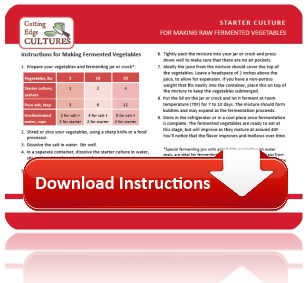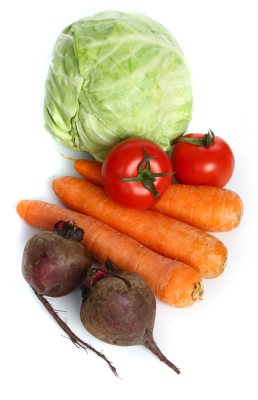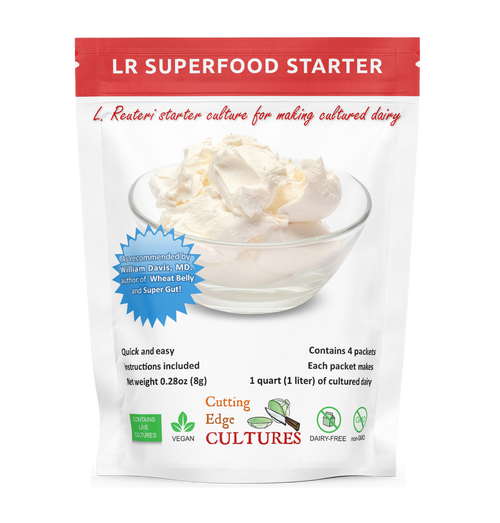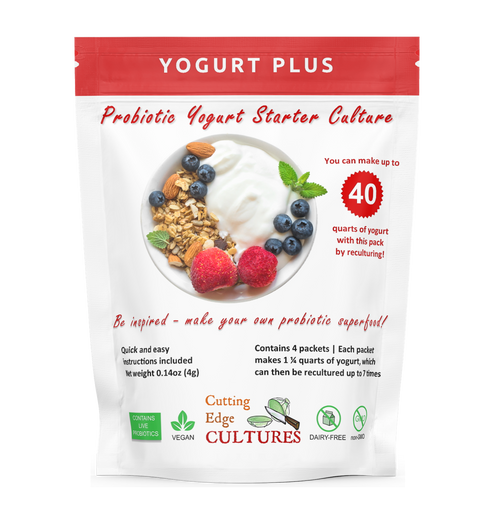Product Overview
 Ingredients: Active bacteria strains (Lb. plantarum, Ln. mesenteroides, Pc. Acidilactici), non-GMO tapioca sugar.
Ingredients: Active bacteria strains (Lb. plantarum, Ln. mesenteroides, Pc. Acidilactici), non-GMO tapioca sugar.
Contains live probiotics. Vegan. Dairy-free. Non-GMO.
Packaged in a facility that also handles products that may contain wheat, soy, eggs, milk, and fish.
Nurture your microbiome with healthy, raw, live superfoods!
Our unique starter culture is designed to help you create probiotic and nutrient rich superfoods, including homemade sauerkraut, kimchee, cultured beets or carrots - and all in the comfort of your kitchen.
Optimize the natural lacto-fermentation process. Supercharge your vegetables, enhance taste and crispness and ensure that your cultured foods are rich in probiotics.
Give your family the best nutrition with tasty, consistent results and a quicker, more complete fermentation*.
*These statements have not been evaluated by the FDA. This product is not intended to diagnose, treat, cure or prevent any disease.
Each box contains 6 sachets; each sachet ferments 5lbs of vegetables.
See here for our research on fermented vegetables.
A Synergistic Blend
Cutting Edge Starter Culture is a synergistic blend of carefully selected strains - each plays a vital role in optimizing the natural lacto-fermentation process to ensure that you achieve healthy and delicious results.
This product is specifically designed to supercharge your cultured vegetables, enhance taste and crispness, and ensure that your fermented foods are rich in probiotics.
Instructions for making fermented vegetables
Ingredients:
-
Vegetables, (thoroughly-washed, preferably organic)
-
Pure salt (fine grind will dissolve easier)
-
Pure, unchlorinated water
-
One sachet* of Cutting Edge Cultures' starter culture per 5lbs of vegetables
Supplies:
- Large pot or bowl
- 2 small containers to dissolve the salt and the starter
- Clean fermenting jars/crocks (with lids)
- Optional: nonporous fermenting weights
Don't have a starter culture for fermented vegetables yet? Get your starter here Each pouch contains 6 sachets; each sachet ferments 5lbs of vegetables
Instructions:

- Prepare your ingredients and fermenting jar or crock. (And thoroughly wash your hands.)
- Shred or slice your vegetables, using a sharp knife or a food processor.
- Dissolve the salt in half of the water.
- In a separate container, dissolve the starter culture in the other half of the water, stir well, and let the solution sit for 10 minutes to activate the bacteria.
- Add the starter and salt solutions to the prepared vegetables and mix thoroughly to ensure even distribution. Add herbs, spices or other ingredients to taste.
- Tightly pack the mixture into your jar or crock and press down well to make sure that there are no air pockets. Leave some headspace for the mixture to expand.
- The juice from the mixture should cover the top of the vegetables. (If needed, add more water and salt solution until the veggies are submerged. There's no need to add more starter. To make the solution, dissolve 3/4 tablespoon of salt in 1 quart of water and add however much is needed. Press down several times to help with even distribution.) Leave a headspace of 2 inches above the juice, to allow for expansion. If you have a nonporous weight that fits neatly into the container, place this on top of the mixture to keep the vegetables submerged.
- Put the lid on the jar or crock and let it ferment at room temperature (70F) for 7 to 10 days. The mixture should form bubbles and may expand as the fermentation proceeds.
- Store in the refrigerator or in a cool place once fermentation is complete. The fermented vegetables are ready to eat at this stage, but will improve as they mature at around 40F. You’ll notice that the flavor improves and mellows over time.
* Special fermenting jars with airlock lids, or crocks with water seals, are ideal for fermenting vegetables. They allow the gas from the fermentation to escape, without exposing the vegetables to the air. But regular mason jars or jars with clampdown lids work well too. Use what you have, and start fermenting!
Note: Store the starter culture in the refrigerator or freezer until you're ready to use it.
Fermented Vegetables FAQs
- Which vegetables can be fermented? Most vegetables can be fermented. The preference is for crunchy/crisp vegetables. Cabbage is the easiest vegetable to ferment. You can make a mixture based on cabbage, and add carrots, ginger, leeks, radishes, garlic, onion, etc., to make a dish called kimchi. Also relatively easy to ferment are carrots and beets. Other vegetables you can ferment are cauliflower, peppers, beans, asparagus, cucumbers, etc.
- Can I use less than a full sachet of starter culture for fermenting smaller quantities of vegetables? Yes, just use the amount of starter culture that you need, and remember to adjust the salt in proportion to the recipe as well. Keep the remaining powder in the sachet, close it well, and store it in the freezer for future use.
- Why is the starter shipped without ice? See "I live in a hot place. Is the starter still active after being shipped unrefrigerated in hot weather?"
- Do you ship to Hawaii / Alaska / Puerto Rico? Yes. Shipping fees to Hawaii, Alaska, and Puerto Rico are the same as to any address within the contiguous USA. We use ambient shipping (non-refrigerated and without ice). Our starters are designed to remain active for several weeks in transit in hot weather, without refrigeration or ice. The formula and the packaging provide excellent protection for the live strains. See "I live in a hot place. Is the starter still active after being shipped unrefrigerated in hot weather?"
- I live in a hot place. Is the starter still active after being shipped unrefrigerated in hot weather? Yes. Our starters are designed to remain active for several weeks in transit in hot weather, without refrigeration or ice. The formula and the packaging provide excellent protection for the live strains. We have thoroughly tested our starters to ensure their viability in long transit during heatwaves, without refrigeration or ice. For this reason, we use ambient shipping, which is significantly less costly for the customer. We keep the starters in a cold warehouse until orders are shipped. When your order is shipped we send you a tracking number so that you can see when it is due to arrive. Once received, the starter should be refrigerated or frozen, and you can use it as normal. See "How will I know my vegetables are properly fermented?" and "I forgot to refrigerate the starter. Is it still active?"
- I forgot to refrigerate the starter. Is it still active? This depends on how long the starter has been left at ambient temperature and if the Best By date is still valid. The starter is designed to remain active for several weeks (and depending on ambient temperatures, even longer) at room/warm temperatures (usually for transit purposes). The formula and the packaging provide excellent protection for the live strains. If the delay is much longer and the temperatures are very high, the viability may be affected. That said, reduction in viability is a slow process that does not happen immediately, even past Best By date. You could try compensating for the possible decrease in viability by increasing the ratio of starter to veggies (for example, by using 2-3 sachets of starter instead of 1, leaving the rest of the ingredients unchanged), and by fermenting for a little longer if needed, to let the bacteria catch up by proliferation over time. See instructions for ratios. Also see "How will I know my vegetables are properly fermented?" There's no harm in consuming inactive bacteria; this is equivalent to consuming no bacteria at all. Remember to keep the starter refrigerated (or frozen) until you're ready to use it. See also "I live in a hot place. Is the starter still active after being shipped unrefrigerated in hot weather?"
- Why do I need to leave some headspace in the vessel? To let the mixture expand. Fermentation creates natural gas which causes the mixture to increase in volume.
- My vegetables are rising in the jar. Is this okay? Yes, this is perfectly normal and expected. Fermented vegetables should rise and expand as they culture, and you’ll find that they can often be very bubbly.
- Can cultured vegetables develop botulism? No. Botulism is an issue with canned goods and not cultured foods. The healthy bacteria in cultured foods prevent botulism from surviving.
- Can I use metal utensils and lids to handle ferments? Overall yes, because the metal used in utensils and food-grade lids is most probably acid-resistant, and the utensil is not going to touch the ferment for that long. Metal lids can be used provided that they are acid-resistant and do not directly touch the fermented product for an extended period of time. Opt for the type of lids with a waxy interior, used for pickles, for example. If that interior is corroded though, better not use them. Also: the jar should not be full all the way to the top, to avoid direct contact between the ferment and the lid. There's no problem using stainless steel in the preparation stage, before fermenting.
- How long do I culture my vegetables on the kitchen counter? Can I leave them for longer/shorter? This depends on the ambient temperature in your home. For most vegetables, culturing takes 7 to 10 days at room temperature. In warmer homes, the vegetables might be ready much faster. The vegetables will continue to ferment at a slower rate after you place them in the refrigerator.
- How will I know my vegetables are properly fermented? They will taste pleasantly sour, will be crunchy, and the liquid will look bubbly. If your culturing has gone wrong, you will know this by the strong unappetizing odor.
- Is fermentation affected by the temperature in my house? Yes. Warm temperature will accelerate fermentation, while cooler temperatures will slow it down. The ideal temperature for vegetable fermentation is 70 F°.
- Can I ferment cooked vegetables? No, it won't work. The starter culture is designed to ferment raw vegetables.
- How long can I store my cultured veggies? In the refrigerator, cultured veggies will keep for up to nine months, and sometimes longer.
- Why aren’t my vegetables crunchy? Salt is the key. Vegetables without salt become soft and slimy. Vegetables made with salt will stay crunchy.
- Why do I need to add salt to the mixture? Salt is an important ingredient in vegetable fermentation. It keeps unfriendly microorganisms at bay and helps improve texture.
- Can these foods be stored out of the fridge after they have been fermented? Technically, cultured vegetables can be stored in a cooler basement or cold cellar. However, they will continue to ferment, and in short order they won’t taste very good.
- What are the white spots on my veggies? This is called Kahm yeast. This yeast is not harmful. It may adversely affect flavor but it won’t hurt you. Not using the freshest vegetables seems to be one of the fastest ways for Kahm yeast to appear.
- What do I do if the liquid leaks from the jar while my veggies culture? If your jar is too full, the brine might leak out. Open the jar, push the veggies down so they are fully covered, and remove some liquid or some veggies.
- What's the best way to store the starter culture? Store the starter culture either in the refrigerator or in the freezer.
- Should I use some of the liquid from my previous batch of fermented veggies as a starter for my next batch? No, this is not recommended. As opposed to other ferments, the original strains do not all survive the acidity of the more advanced phases of the fermentation (which they helped achieve). We therefore recommend using a starter culture sachet (or sachets) for each batch. Each pouch of our vegetable starter contains 6 individual sachets. Each of those sachets ferments 5 lbs. (about one gallon) of vegetables. That's a total of 30 pounds of fermented veggies per pouch!
- There's not enough brine in the jar to cover the vegetables. The veggies need to be submerged. This can often be achieved by packing them down as tightly as possible. Some vegetables (like cabbage) produce their own 'juice' upon pounding, and this helps to have more brine. Another option is adding more water and salt solution until the veggies are submerged. There's no need to add more starter. To make the solution, dissolve 3/4 tablespoon of salt in 1 quart of water and add however much is needed. Press down several times to help evenly distribute the newly-added solution in the jar.
- What are the starter's caloric/nutrition facts? These are printed on the back of the pouch. But overall, our starters contain such minuscule quantities of powder, that they are too tiny to have any impact on the final ferment's caloric values. Our starters come in sachets of 1g - 3g of powder (depending on the starter), most of which, apart from the live strains, is either a carrier fiber containing no caloric value, or a trace of a natural sugar containing only a negligible value. When these teensy quantities of 1g - 3g are added to a gallon of vegetables, the starter's original caloric values, if ever there were any, become entirely diluted in the overall mass, and are practically non-detectable. The final ferment's nutritional values of calories/fats/carbs etc., come directly from the vegetables that the starter was added to, not from the starter itself. For example, fermented cabbage will contain some small amount of natural sugar because cabbage contains some natural sugar inside its leaves; carrots and beets also contain natural sugars, etc.
- Where is the starter made? In the USA.
- Is the starter gluten-free/soy-free/dairy-free/lactose-free/vegan? Although the starter contains no gluten, no soy, no animal products, and no dairy (and hence no lactose), it is packaged in a shared facility that also handles products that may contain wheat, soy, eggs, milk, and fish.
- Is the starter certified Kosher? No. Our starters are not certified Kosher.
- My starter has expired. Can I still use it? This depends on how much time has passed since expiration, and whether the starter has been kept refrigerated/frozen. After expiration date, the starter's viability slowly decreases over time. If the starter had been kept cold, there is a chance it is not entirely inactive, even after several months or a year and longer past Best By date. You could try testing it by making a small batch of only one quart (to minimize waste in case this doesn't work). Use one whole sachet of starter, instead of just 1/8 of a tsp., to compensate for the loss of viability. You could also extend fermentation time, if needed. See instructions. Also see "How will I know my vegetables are properly fermented?" If all goes well, you could later use the rest of the starter to make future batches, either according to the ratios mentioned in the instructions, or by increasing the ratio of starter to vegetables, in order to compensate for reduced viability (for example, by using 2-3 or more sachets to make one gallon). No harm in consuming inactive bacteria. This is equivalent to consuming no bacteria at all. Remember to keep the starter refrigerated (or frozen) until you're ready to use it. If purchasing a new starter, the Best By date is printed on the pouch and on each sachet inside the pouch. If kept frozen/refrigerated, the starter will last a few additional months beyond the Best By date.













